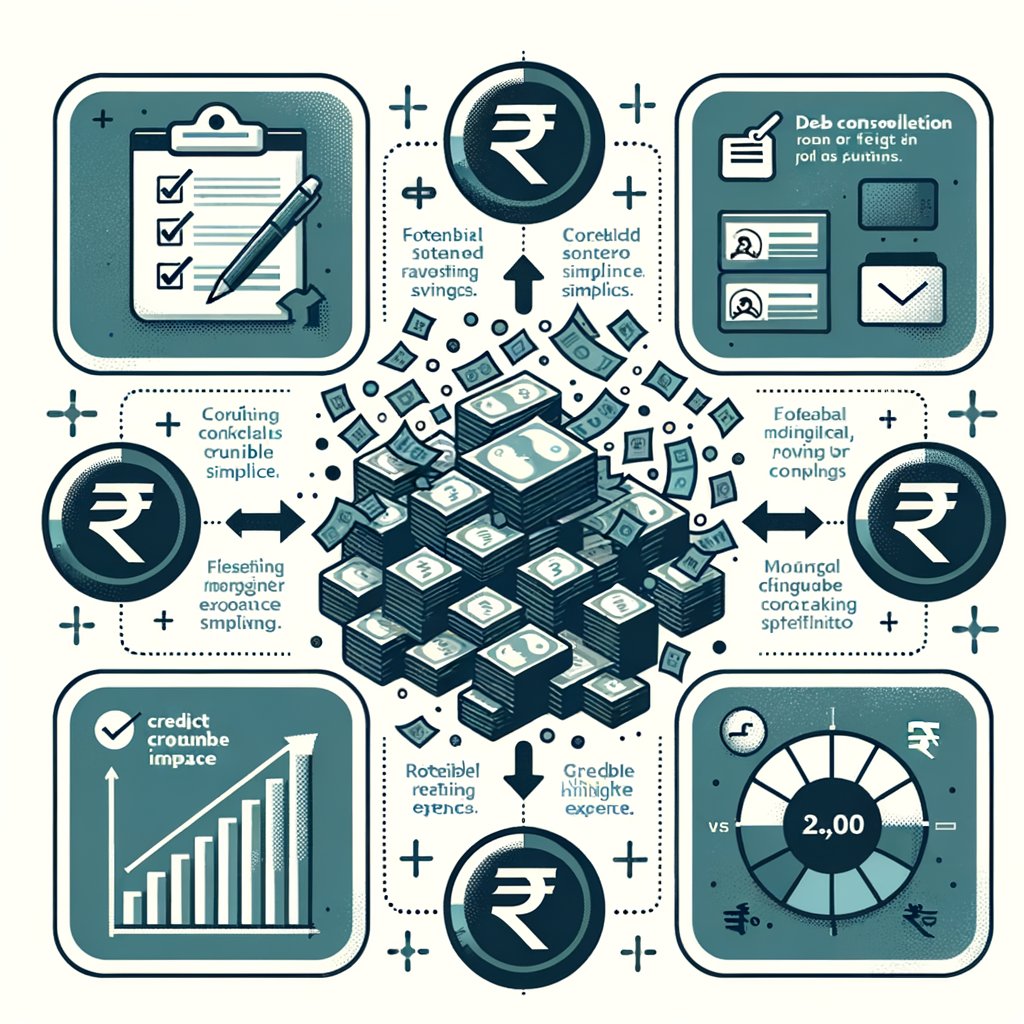The Pros and Cons of Using Debt Consolidation Services in India
Juggling multiple EMIs, credit card bills, and personal loan payments at the end of every month can feel like a relentless financial marathon. For both salaried professionals and small business owners across India, this scenario is all too common, creating stress and making it difficult to get ahead. If this sounds familiar, you may have come across the term debt consolidation. This financial strategy involves combining multiple debts into a single, more manageable loan, but is it the right move for you? This article aims to provide a balanced view by exploring the pros and cons of debt consolidation India, helping you understand how debt consolidation services work and what crucial factors you need to consider before making a decision.
Understanding Debt Consolidation Services in India
Before diving into the advantages and disadvantages, it’s essential to grasp the fundamental concept and process of debt consolidation as it applies in the Indian financial landscape. Gaining a clear picture of how it works is the first step in determining if it aligns with your financial goals. A thorough grasp of understanding debt consolidation services in India is crucial for anyone considering this path to financial stability.
What is Debt Consolidation? A Simple Explanation
At its core, debt consolidation is the process of taking out a new, single loan to pay off several existing, often high-interest, debts. Think of it like this: instead of having various bills and papers scattered across your desk, you are moving all of them into one organized, neatly labelled box. This “box” is your new consolidation loan.
The primary goals of this strategy are threefold:
- Simplify Payments: You no longer need to track multiple due dates and amounts. Instead, you have one single EMI (Equated Monthly Instalment) to pay each month.
- Reduce Interest Cost: Often, the new loan comes with a lower interest rate than the combined rates of your previous debts, especially high-interest credit card debt.
- Create a Clear Path to Freedom: The new loan has a fixed term, giving you a clear timeline and a definite end date for when you will be completely debt-free.
How the Process Works Step-by-Step
The journey of using debt consolidation services typically follows a structured four-step process. Understanding each stage will demystify the procedure and prepare you for what to expect.
- Step 1: Debt Assessment: The first step involves a comprehensive evaluation of all your outstanding debts. You or a financial service provider will calculate the total amount you owe across all unsecured loans, such as credit card balances, personal loans, and consumer durable loans. This gives you the target loan amount you need to apply for.
- Step 2: Securing a New Loan: With the total debt amount calculated, you’ll apply for a new loan to cover it. This could be a personal loan, a loan against property, or another suitable financial product. Lenders will thoroughly review your application, with a heavy emphasis on your CIBIL score. A strong credit score (typically 750 or above) is critical to securing a loan with a favourable interest rate.
- Step 3: Paying Off Old Debts: Once your new loan is approved and the funds are disbursed, the money is used to systematically pay off and close all your previous loan accounts and credit card balances. It is crucial to ensure that all these accounts are officially closed to prevent any future issues and to see a positive impact on your credit report.
- Step 4: Managing the New Loan: After clearing your old debts, you are left with only one loan to manage. Your financial life simplifies to making a single, fixed EMI payment on a specific date each month until the loan tenure is complete.
The Pros: Unpacking the Benefits of Using Debt Consolidation Services in India
When executed correctly, debt consolidation can offer significant relief and a clear path forward. Let’s delve into the specific advantages that make this one of the most popular debt management strategies for Indian consumers. These are the key benefits of using debt consolidation services in India.
Simplified Financial Management
One of the most immediate and tangible benefits is the sheer convenience of simplification. Instead of juggling five or six different payment due dates, interest rates, and minimum payment amounts for various credit cards and loans, you have just one EMI on one fixed date. This drastically reduces the mental load and administrative hassle of managing your finances. The reduced complexity also lowers the risk of accidentally missing a payment, which in turn helps you avoid late payment fees and penalties that can quickly spiral out of control. This newfound simplicity can significantly decrease financial stress and allow you to focus on a single, clear repayment goal.
Potential for a Lower Interest Rate
This is perhaps the most powerful financial incentive for debt consolidation. High-interest unsecured debts, particularly credit card debt, can carry annual percentage rates (APRs) as high as 36-42%. Consolidating these into a personal loan, which might have an interest rate between 11% and 18%, can lead to substantial savings.
Let’s look at a hypothetical example:
| Debt Type | Outstanding Amount | Interest Rate (p.a.) | Monthly Interest |
|---|---|---|---|
| Credit Card 1 | ₹1,50,000 | 36% | ₹4,500 |
| Credit Card 2 | ₹50,000 | 40% | ₹1,667 |
| Personal Loan 1 | ₹1,00,000 | 18% | ₹1,500 |
| Total | ₹3,00,000 | ~31.3% (Weighted Avg.) | ₹7,667 |
Now, if you take a new personal loan for ₹3,00,000 at 14% p.a. to pay off these debts, your new monthly interest would be just ₹3,500. This is a saving of over ₹4,000 per month on interest alone, money that can be used to pay down the principal faster or meet other financial goals.
Improved Credit Score (in the Long Run)
While applying for a new loan triggers a “hard inquiry” that can cause a small, temporary dip in your CIBIL score, the long-term effects of successful debt consolidation are overwhelmingly positive. Here’s why:
- Timely Payments: Making consistent, on-time payments for a single loan is easier than for multiple accounts. A strong payment history is the single most important factor influencing your credit score.
- Lower Credit Utilization Ratio (CUR): Once you use the consolidation loan to pay off your credit card balances, your CUR—the ratio of credit you’re using to your total available credit—drops significantly. Lenders view a lower CUR (ideally below 30%) as a sign of responsible credit management.
- Closing Accounts: Clearing and closing multiple smaller loan accounts simplifies your credit profile, which can also be viewed favourably over time.
A Fixed Repayment Schedule
Unlike the revolving nature of credit card debt, where you can get stuck in a cycle of making minimum payments without reducing the principal, a consolidation loan is a term loan. It comes with a fixed repayment tenure (e.g., 36, 48, or 60 months). This provides a clear finish line. You know exactly when your debt will be fully paid off, which instills a sense of control and discipline. This structured approach is a cornerstone of effective debt management strategies for Indian consumers, transforming a seemingly endless debt cycle into a manageable project with a defined end date.
The Cons: Key Risks and Drawbacks to Consider
While the benefits are compelling, it’s crucial to approach this decision with a clear understanding of the potential downsides. Ignoring these risks can lead you into a worse financial situation. A balanced examination of the pros and cons of debt consolidation India is essential.
Upfront Costs and Processing Fees
Securing a new loan is rarely free. Lenders charge various fees that can add to the overall cost of borrowing. You must factor these into your calculations:
- Processing Fees: Most banks and NBFCs charge a non-refundable processing fee, typically ranging from 1% to 3% of the total loan amount.
- Administrative Charges: There may be other smaller fees for documentation, verification, and other administrative tasks.
- Prepayment Penalties: Some of your old loans might have prepayment or foreclosure charges, which you’ll need to pay when closing them with the new loan amount.
Always ask for a detailed breakdown of all associated costs and calculate the total cost of the new loan, not just the advertised interest rate.
Risk of a Longer Loan Tenure
To make the new EMI more affordable, you might be tempted to opt for a longer loan tenure. While a lower monthly payment provides immediate relief, it can be a costly trap in the long run. A longer tenure means you will be paying interest for a greater number of years.
For example, consider a ₹5 lakh loan at 13% interest:
- 3-Year Tenure: EMI is ~₹16,847. Total interest paid is ₹1,06,492.
- 5-Year Tenure: EMI is ~₹11,377. Total interest paid is ₹1,82,620.
While the monthly payment is over ₹5,000 lower with the 5-year plan, you end up paying nearly ₹76,000 more in total interest. Always try to choose the shortest possible tenure with an EMI you can comfortably afford.
Doesn’t Solve Underlying Spending Habits
This is the most critical risk of all. Debt consolidation is a financial tool, not a behavioural cure. It reorganizes your existing debt but does nothing to address the spending habits that created the debt in the first place. There’s a significant psychological risk that once your credit cards are paid off and show a zero balance, you might be tempted to start spending on them again. If this happens, you’ll be burdened with the new consolidation loan and fresh credit card debt, pushing you into an even deeper financial hole. This strategy is only effective when paired with a strict budget and a commitment to financial discipline. Recognizing and avoiding What common mistakes do individuals make in financial planning and how can I avoid them? is crucial for long-term success.
Strict Eligibility and Credit Score Requirements
The success of debt consolidation hinges on securing a new loan at a lower interest rate. However, the best rates are reserved for applicants with excellent credit history. To qualify for a low-interest personal loan, you will typically need a CIBIL score of 750 or higher, along with a stable and sufficient income. Knowing your score is the first step, and you can learn How to Track Your Credit History Using Your PAN Card Via CIBIL. If your credit score is already damaged due to missed payments, you may not qualify for a new loan at all. If you do get approved, it might be at a very high interest rate that defeats the entire purpose of consolidation, offering no real savings.
Finding the Best Debt Consolation Options for Indians
If you’ve weighed the pros and cons and decided to proceed, the next step is to choose the right financial product. The best debt consolidation options for Indians depend on your credit profile, the total debt amount, and whether you own any assets.
Personal Loan for Debt Consolidation
- Who it’s for: This is the most common option, ideal for salaried individuals and business owners with good credit scores who need to consolidate unsecured debts like credit cards and other smaller personal loans.
- Pros: It’s an unsecured loan, meaning you don’t need to pledge any collateral. The application and disbursal process is relatively quick.
- Cons: Interest rates are higher compared to secured loans, and the loan amount may be capped based on your income.
Loan Against Property (LAP)
- Who it’s for: This is suitable for individuals or business owners who have a larger amount of debt (typically above ₹10-15 lakhs) and own a residential or commercial property that can be used as collateral.
- Pros: Interest rates are significantly lower than personal loans. You can get a much larger loan amount and a longer repayment tenure (up to 15 years).
- Cons: It is a secured loan, which means your property is at risk if you default on payments. The processing time is longer due to property valuation and legal verification.
Credit Card Balance Transfer
- Who it’s for: This option is specifically for individuals whose primary debt is spread across multiple high-interest credit cards.
- Pros: Many banks offer a promotional low-interest or even 0% interest period for the first 3-6 months on the transferred amount, giving you a window to pay down the principal aggressively.
- Cons: After the introductory period ends, the interest rate usually reverts to a very high rate. There is always a processing fee (around 1-2%), and this method can only be used to consolidate credit card debt, not other types of loans.
Conclusion
Ultimately, debt consolidation services can be a powerful and effective strategy for regaining control of your finances in India. The simplification of payments, potential for significant interest savings, and a clear path to becoming debt-free are compelling benefits. However, this financial tool is not a magic bullet. It’s crucial to weigh the pros and cons of debt consolidation India against your personal financial situation and, most importantly, your spending habits. The risks of upfront fees, the potential for paying more interest over a longer tenure, and the failure to address underlying financial discipline are real and must be taken seriously.
Feeling overwhelmed by multiple debts? It’s important to make an informed choice. The financial experts at TaxRobo can help you analyze your debt-to-income ratio, evaluate your options, and guide you towards the most effective debt management strategy. Contact us today for a personalized financial consultation.
Frequently Asked Questions (FAQs)
1. Will using debt consolidation services in India damage my CIBIL score?
There might be a temporary small dip in your CIBIL score due to the hard inquiry made by the lender when you apply for the new loan. However, this is a minor and short-term effect. By consistently paying the single EMI on time, clearing your old debts, and lowering your overall credit utilization, your CIBIL score is highly likely to improve significantly in the long run.
2. What is the difference between debt consolidation and debt settlement?
Debt consolidation and debt settlement are very different. Debt consolidation involves taking a new loan to pay your existing debts in full. You still honour your original obligations. Debt settlement involves negotiating with your creditors to pay back only a portion of what you owe, with the remainder being forgiven. While it might sound appealing, settlement severely harms your credit score for up to seven years and should only be considered a last resort in extreme financial distress.
3. Can I consolidate business loans and personal loans together?
While it may be technically possible for some lenders to offer a large personal loan that you could use for this purpose, it is generally advisable to keep business and personal finances separate for accounting, tax, and legal liability reasons. A better approach for entrepreneurs is to look for specific business loan consolidation products offered by financial institutions. Consulting a financial advisor to explore the best structure for your situation is highly recommended.
4. What are the typical eligibility criteria for a debt consolidation loan in India?
The eligibility criteria can vary between lenders, but some common requirements include:
- A stable and verifiable source of income (for both salaried and self-employed individuals).
- A good CIBIL score, usually 750 or higher, is crucial for approval and getting a low interest rate. You can check your score on the official CIBIL website here.
- A manageable debt-to-income ratio (DTI), meaning your total monthly debt payments (including the proposed new EMI) should not exceed a certain percentage of your monthly income (often 40-50%). For more on this, read about Understanding Your Debt-to-Income Ratio and Its Impact on Your Finances.
- Meeting the lender’s age (e.g., 21-60 years) and residency requirements.



